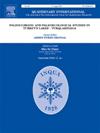The effects of redeposition phenomena on the reconstruction of palaeoenvironment in the southeastern Baltic Sea
IF 1.8
3区 地球科学
Q3 GEOGRAPHY, PHYSICAL
引用次数: 0
Abstract
The coastal waters of the southeastern Baltic Sea, up to a depth of approximately 60–65 m, experienced the significant basin regression at the very end of the existence of the Baltic Ice Lake and the beginning of Yoldia Sea, as well as some transgressions during the Ancylus Lake and Litorina Sea stages. In the Lithuanian waters, two 5-m cores, taken from different depths and sedimentary zones were analysed. The radiocarbon dating, diatom and pollen analysis, loss on ignition and magnetic susceptibility methods were employed in order to reconstruct the environmental conditions that influenced the sedimentation process in the coastal waters. The prevalence of fresh-brackish benthic diatoms throughout the sediment sequences indicates that shallow freshwater environments existed in the coastal waters of the various Baltic Sea basins from the Late Glacial until the Middle Holocene. The results of the integrated studies revealed radiocarbon age reversals and inconsistencies between sediment ages and the results of diatom and pollen studies. The frequent stratification of sandy sediments with organogenic sediment interlayers indicates the redeposition of sediments of different origins and ages during the transgressions of the Ancylus Lake and Litorina Sea. The highly variable content of freshwater planktonic-benthic diatoms, as well as presence of brackish diatoms in organogenic sediments, confirm an unstable environment in the coastal waters during the basin's transgressional phases. In summary, the studies indicate that the stratigraphic identification of sediments in coastal waters is problematic due to the specific sedimentary environment in which they are deposited. This also complicates the reconstruction of the palaeogeographic conditions of entire basins during the different stages of the Baltic Sea development. When interpreting the radiocarbon ages and palaeobotanical data, the specific sedimentary environment of coastal waters should be taken into account.
波罗的海东南部再沉积现象对古环境重建的影响
波罗的海东南部沿海水域深度约60 ~ 65 m,在波罗的海冰湖存在末期和约尔迪亚海形成初期经历了明显的盆地退缩,以及在Ancylus湖和Litorina海阶段经历了一些海侵。在立陶宛水域,研究人员分析了取自不同深度和沉积带的两个5米岩心。采用放射性碳定年、硅藻和花粉分析、着火损失和磁化率等方法,重建了影响沿海水域沉积过程的环境条件。咸淡底栖硅藻在沉积物序列中的普遍分布表明,从晚冰期到全新世中期,波罗的海各盆地的沿海水域存在浅层淡水环境。综合研究结果揭示了沉积物年龄与硅藻和花粉研究结果之间的放射性碳年龄反转和不一致。砂质沉积物与有机沉积层间的频繁分层表明,在安丘勒斯湖和利托里纳海海侵期间,不同来源和年龄的沉积物发生了再沉积。淡水浮游底栖硅藻含量的高度变化,以及有机沉积物中微咸硅藻的存在,证实了盆地海侵期沿海水域的不稳定环境。综上所述,这些研究表明,由于沉积物沉积的特定沉积环境,沿海水域沉积物的地层识别存在问题。这也使整个盆地在波罗的海不同发育阶段的古地理条件的重建变得复杂。在解释放射性碳年龄和古植物学数据时,应考虑到沿海水域的特定沉积环境。
本文章由计算机程序翻译,如有差异,请以英文原文为准。
求助全文
约1分钟内获得全文
求助全文
来源期刊

Quaternary International
地学-地球科学综合
CiteScore
5.60
自引率
4.50%
发文量
336
审稿时长
3 months
期刊介绍:
Quaternary International is the official journal of the International Union for Quaternary Research. The objectives are to publish a high quality scientific journal under the auspices of the premier Quaternary association that reflects the interdisciplinary nature of INQUA and records recent advances in Quaternary science that appeal to a wide audience.
This series will encompass all the full spectrum of the physical and natural sciences that are commonly employed in solving Quaternary problems. The policy is to publish peer refereed collected research papers from symposia, workshops and meetings sponsored by INQUA. In addition, other organizations may request publication of their collected works pertaining to the Quaternary.
 求助内容:
求助内容: 应助结果提醒方式:
应助结果提醒方式:


